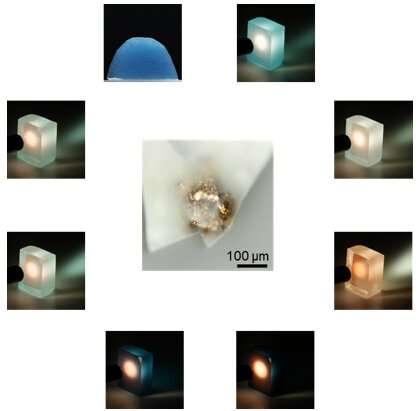This article has been reviewed according to Science X's editorial process and policies. Editors have highlighted the following attributes while ensuring the content's credibility:
fact-checked
peer-reviewed publication
trusted source
proofread
Fine-tuning gold nanoparticles in tellurite glass for unique photonics

Silicate glass is a commonly-used glass found in most households, in drinking glasses or windowpanes for example. The integration of gold nanoparticles (NPs) in silicate glass has been used in art and decoration for centuries. These NPs impact the way the silicate glass interacts with light through the now well-known phenomenon called localized surface plasmon resonance.
This unique light modulation behavior has opened up applications from colored glass to special optical components. The ability to uniquely modulate light in gold NPs has inspired the scientific community to utilize these NPs in other glass types to generate new optical functionalities.
Of the many glass types investigated, tellurite glass has been of particular interest since it exhibits a unique combination of properties. Tellurite glass is somewhat easy to fabricate, is durable, has low phonon energy, possesses a wide transmission window, and has high solubility of luminescent rare earth ions, allowing these ions to emit bright light over a wide spectral range from visible to infrared light.
These are important features for optics, lasers, and telecommunications technologies such as fiber optics, laser systems, and sensing technologies. To achieve the desired light modulation behavior, the size, shape, distribution, and quantity of the gold NPs must be controlled carefully. However, the technique commonly used for precisely forming gold NPs silicate glass, the so-called striking technique, has proven insufficient to achieve precise control of gold NPs in tellurite glass.
In a paper published in Light: Science & Applications, a team of scientists including Professor Heike Ebendorff-Heidepriem and Dr. Yunle Wei from the Institute for Photonics and Advanced Sensing (IPAS), School of Physics, Chemistry and Earth Sciences, The University of Adelaide, Australia, as well as Dr. Jiangbo Zhao from the School of Engineering at the University of Hull, United Kingdom, and co-workers in Germany have developed a new approach to form gold NPs in tellurite glasses.
The team devised the new approach by identifying the challenges of the traditional striking technique to create gold NPs in tellurite glass and through a serendipitous discovery of gold NP formation in tellurite glass.
Based on this advance in knowledge and chance discovery, the team developed completely new methods for both steps of the striking technique: (i) a controlled cold crucible corrosion technique to incorporate gold ions into the glass, and (ii) a glass powder reheating technique to transform the gold ions to gold NPs.
Dr. Yunle Wei, co-inventor of the new technology and postdoctoral researcher within Professor Heike Ebendorff-Heidepriem's team says, "This is a perfect example of turning a serendipitous discovery into an innovative technology with potential for real-world impact, thanks to great teamwork among collaborators."
The innovation of precise control over the gold NP formation in tellurite glass provides guidance for designing and manipulating the plasmonic properties in tellurite glass for exciting photonics research and applications in the future.
More information: Yunle Wei et al, Controlled formation of gold nanoparticles with tunable plasmonic properties in tellurite glass, Light: Science & Applications (2023). DOI: 10.1038/s41377-023-01324-x
Journal information: Light: Science & Applications
Provided by Chinese Academy of Sciences


















